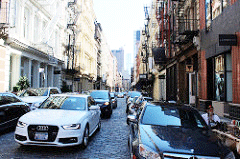A core environmental justice fight has long been the fair distribution of necessary nuisance uses throughout a city. Poor neighborhoods tend to be over-burdened with unpleasant parts of public infrastructure like bus depots and sewage plants, with cumulative negative effects on health and quality of life.
Often activists in these over-burdened neighborhoods band together to fight the location of yet another of these kinds of facilities, which leads to inevitable labeling of them as just naysayers and exchanges like “Well where should they go?” “How about the rich neighborhoods take their share?” “Yeah, like that will happen.”
Well, in New York City, former Mayor Bloomberg apparently decided to make it happen, roughly, with a solid waste plan that at least declared that each of the city’s five boroughs should take adequate responsibility for its own trash. And Mayor DeBlasio is sticking with the plan.
This means, as CityLab‘s Aarian Marshall recently reported, that SoHo, a Manhattan neighborhood full of luxury apartment towers and a median income of $111,000/year, has been forced to accept, despite protest from some very wealthy and powerful people, a large building that includes a garage for sanitation trucks.
Hats off to both mayors for this very basic, and yet radically important policy. May it be extended to all similar types of uses.
Now, the main point of the CityLab piece is that in response to all the protest, the facility was designed super, super carefully to not actually be an imposition to its neighbors, from the overall aesthetic down to the angle of the truck ramp not shining headlights into residential windows.
I think we should all be talking this up for a couple reasons:
First, as Marshall says, “The real test of New York’s commitment to infrastructure design, however, will come in the less tony neighborhoods. Are all New Yorkers worthy of silvery, thoughtful design?” We have now proven that this particular kind of infrastructure doesn’t have to be horrible for its neighbors—and therefore no future example in any location should ever be built to or operated at a lower standard, even if that neighborhood’s residents can’t or don’t hold the city’s feet to the fire in the same way.
I think we need to also state the flip side of that, though: we have now proven that this particular kind of infrastructure doesn’t have to be horrible for its neighbors, but that still doesn’t mean you want a whole neighborhood full of them. Therefore NIMBYs in other wealthy neighborhoods that do not yet have an equitable share of this kind of infrastrucuture should not be given particular deference or be allowed to derail the process of one getting built. (Community involvement to create context-sensitive design is still important though. And so is questioning whether some things, like an underwater fracked gas pipeline, should be built at all.)
I do wonder if implementing this sort of equitable distribution would be a little harder in places outside of Manhattan, where even wealthy residents have accepted some level of crowding, grit, and odor as the price of being in the city that never sleeps, but I still think the principle applies everywhere and should be emulated.
In the end it comes down to why environmental justice is essential to the environmental movement as a whole—as soon as we’re all potentially “downwind”/“downstream,” that’s when we’ll start doing things differently, whether it’s switching away from diesel fuel and enforcing idling laws, reducing the amount of trash we make so we don’t need a new transfer station, or deciding to go for all renewables by 2030 so no one gets a pipeline in their backyard.
(Photo credit: ‘SoHo,’ by Shinya Suzuki via flickr, CC BY-ND 2.0)






Comments